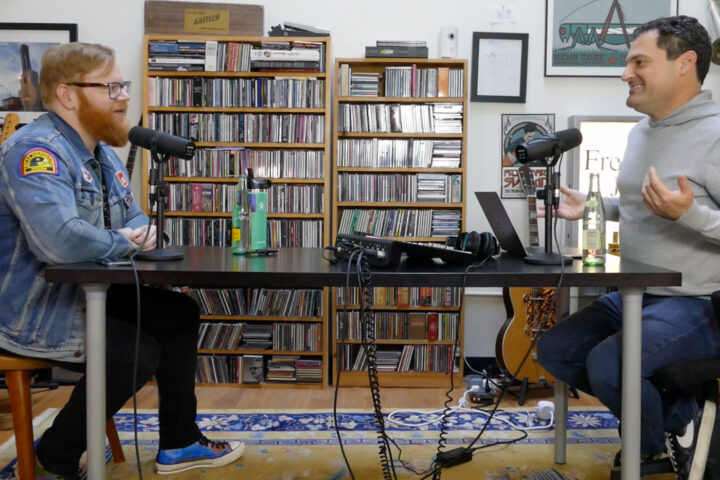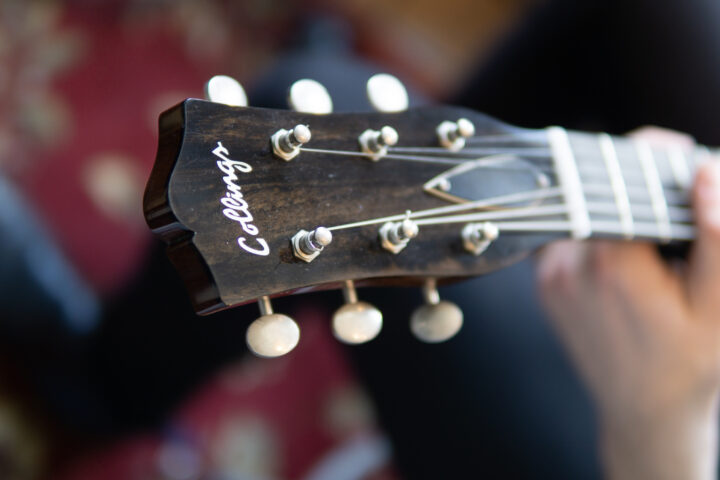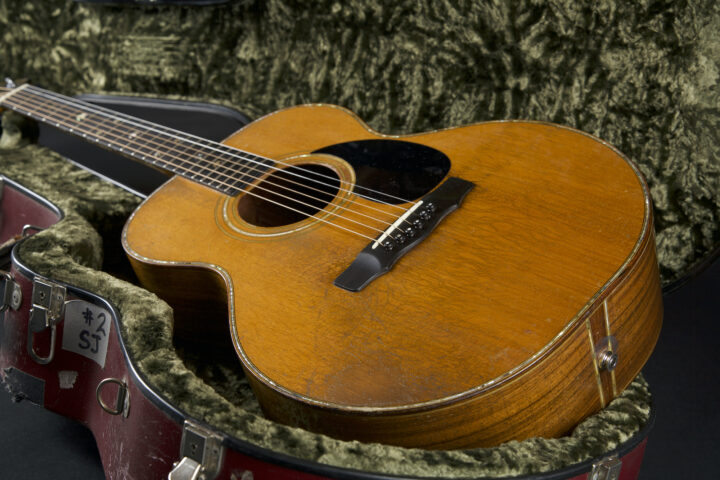This story starts at Los Angeles’ Rhino Records. There, a young musician worked behind the counter, selling used LPs, cutouts and bootlegs, what the store mostly carried at the time. He did this from 1976 to 1985. And while there have always been a lot of musicians running shrink-wrappers at the Towers, Virgins and Amoebas of the world, as the stories unfold it’s clear that this wasn’t just a job for our subject: It shaped his music world and gave him references that today—four decades later—he’s still pulling out of his magician’s hat. That musician is guitarist Nels Cline.
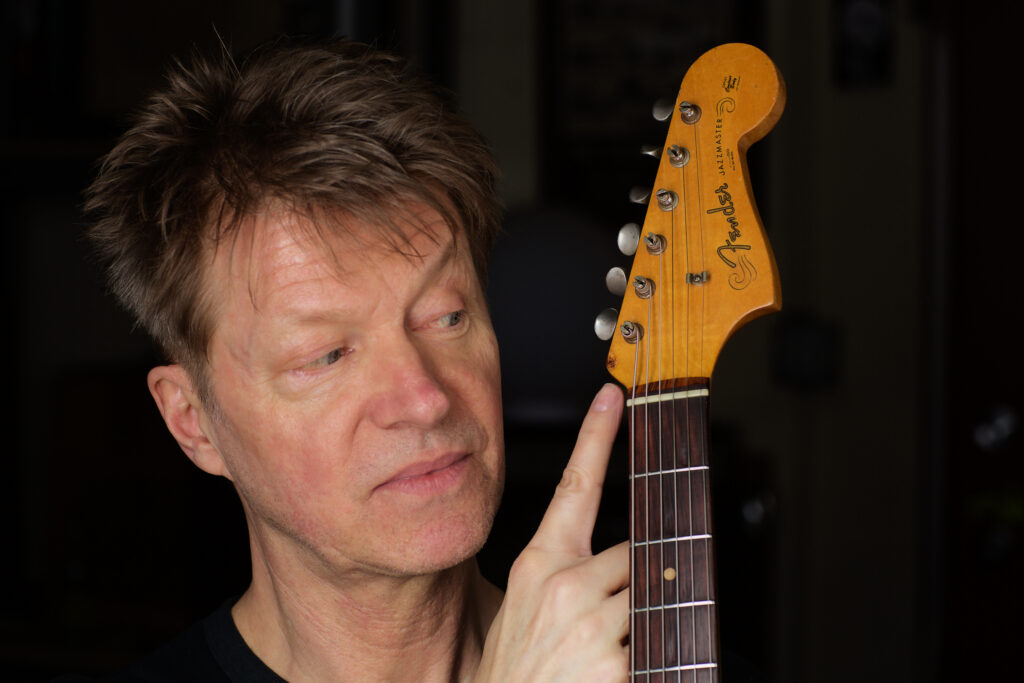
Though Cline is best known these days for his work in Wilco, he made a lot of connections back at Rhino. It’s where he met fellow musicians and heroes such as Carla Bley and Charlie Haden (he also mentions David Hidalgo, Dave Alvin and Lux Interior of the Cramps as frequent shoppers). At one point, Cline was the guy who introduced customer George Winston to fellow customer Will Ackerman. He also heard a lot of music at that store—punk and free jazz that would shape his view of improvisation and tone. But it wasn’t all experimental music on the Rhino turntable; he also heard Jim Hall, Henry Mancini and Johnny Mandel, all those ubiquitous …With Strings albums. So perhaps one shouldn’t be shocked that Lovers, Cline’s 2016 double album on Blue Note, isn’t filled with distortion and noise but, well, pretty melodies. It’s a classic, ensemble jazz album. It’s mood music.
“As a jazz guy, I’ve always been drawn to moodier projects by various people,” Cline explains from his home in New York. “Orchestrated jazz projects such as Miles with Gil Evans, Gary McFarland comes to mind, Johnny Mandel, Henry Mancini soundtracks…
“At Rhino Records, I was always putting the mood music and novelty album covers up in the bathroom, which I think is pretty common practice in record stores at this point. Then, I ended up hearing some of them just sort of out of curiosity and finding weird pleasures in not too generic or not too corny versions of so-called pop songs of the day,” Cline says. “I thought, what if someone did an updated idea of this mood music idea? The record you put on when you get a date over to your bachelor pad and turn the lights down and mix the martinis and sit too close on the couch. But it’s not corny in that way. It may be romantic, but it has more edge, or more darkness, or it has more reality.”
Cline first had the idea to record this project—or something like it—in the ’80s. He’d fall in love with music he’d find on old LPs or in movies —The Night Porter theme, “Search for Cat” in Breakfast at Tiffany’s (“one of the most amazing pieces of music…the genius of Henry Mancini,” he says), Jimmy Giuffre’s “Cry, Want” —and wanted to do his own interpretations. “I just thought that that would be a good ‘mood music’ record—to have references to the darker and maybe more erotic aspects of romance and mood. I kept this idea percolating in my head for years. The list [of songs] grew and grew.”
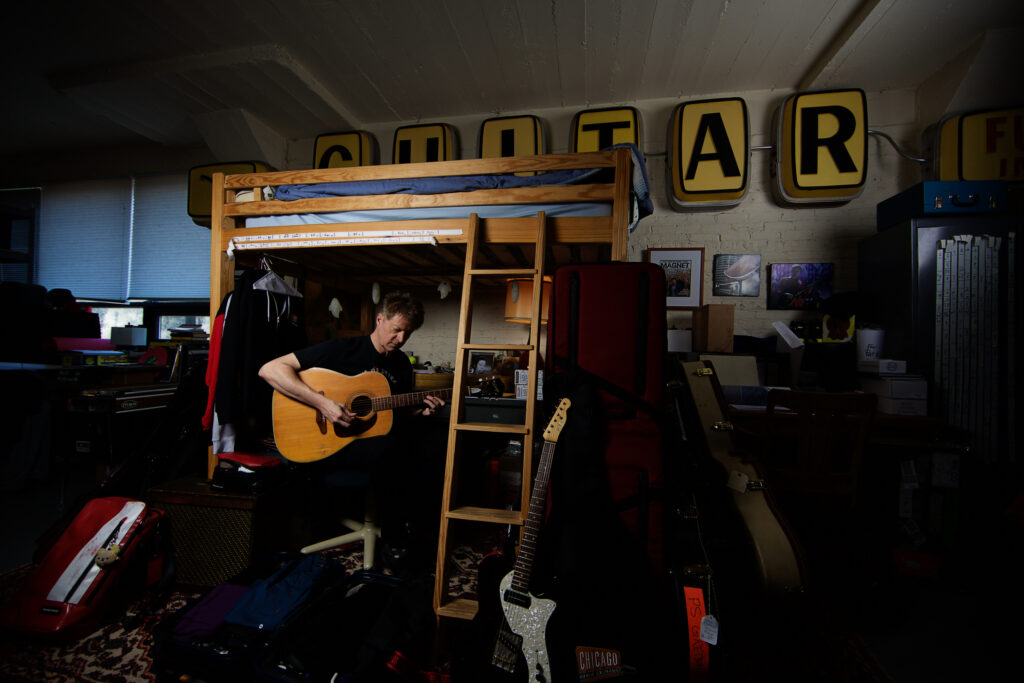
Nels Cline grew up in West Los Angeles. Both of his parents worked for the Los Angeles City School System; his dad taught English and history primarily, while his mom taught speech. They both fostered a love for the arts and, especially, music. “I’d been interested in Indian classical music since elementary school,” he casually mentions in passing. Prior to Nels and his twin brother, Alex, no one in his family played music, but, according to Nels, “There were records. My dad was into Ella Fitzgerald and Lena Horne, but really into musicals. So Alex and I grew up seeing more musicals and plays than movies. My mom liked opera. She had been a singer in her tiny, tiny nontown in South Dakota, but didn’t pursue it. She sang in church and everyone thought she was great, apparently. She won some contest. But then she never wanted to compete. Both my folks coulcarry a tune and would burst into song.”
Cline took up the guitar when he was around 12. “Initially, I played with my thumb on my right hand and just two fingers on my left,” he remembers. “I played mostly with two fingers all the way to high school.” In junior high, he formed his first band, Toe Queen Love. (The band’s name came from the inside of a Fugs album.) “We did instrumental riffs that turned into long jams, a la the Allman Brothers, and some covers like ‘Memory Pain’ by Johnny Winter or ‘Your Blues’ by the Beatles, which I would sing, by the way,” he says with a laugh. “I was just learning one chord after another slowly by watching other people play.”
Cline is basically self-taught, having burned through a variety of instructors in his early days. “It just never worked out with guitar teachers,” he explains. “I had one guitar teacher when I was in high school pretty much almost ruined me for life. It was just a very negative situation. I thought it was all me. It turns out later I figured out this guy was a complete idiot, but it took me about 10 years to figure that out.”
In their teens, Nels and Alex discovered jazz. “I still don’t know to this day how I ended up in our friend Bill Watts’ apartment, but he wasn’t there,” he remembers of the fateful day. “No one was there but me and my brother. We put on a copy of John Coltrane’s His Greatest Years, Volume 1 that our friend David Hirschman had lent Alex. David had bought it for his dad [the poet Jack Hirschman]. He thought Alex would like it, because Alex liked ‘all that instrumental Frank Zappa stuff.’
“So we put on this record and the first piece was ‘Africa.’ I was completely devastated,” Cline says. “I didn’t know anything about modal jazz. I didn’t know anything about what was happening. My brother had the same reaction. Through high school, we embarked on a path of exploration to discover what was happening in jazz. At that time, it was the birth of jazz rock: Tony Williams’ Lifetime, Bitches Brew, Live-Evil. Weather Report started in ’71. My brother delved right away into the AACM, Art Ensemble of Chicago, Anthony Braxton, Leo Smith, Muhal Richard Abrams, Kalaparusha Maurice McIntyre, all those guys. And we started listening to progressive rock through our friend Lee Kaplan, especially Yes and Van der Graaf Generator and stuff like that. And that led us to ECM Records.”
The Cline boys were fully down the rabbit hole at this point. With their allowance money, they’d take buying trips to Moby Disk in the San Fernando Valley to scoop up import LPs.
“We’d buy a record every two weeks,” he says. “And then we started finding out where the shows were. The first jazz concert we ever went to was at Shelly’s Manne-Hole, the Kenny Burrell Trio. Shelly’s was a beautiful little club, all ages, but we had to borrow our mom’s car and drive there. We went there, and I remember Shelly Manne and His Men opened. It was around the time of their album Mannekind. A fantastic record and we were just in love with it. We were so freaked out by how good they were. And then Kenny Burrell’s Trio was like the quietest music I’d ever heard. It was so quiet. I just thought, ‘Wow, this is so different. This is so wild. They’re so quiet.’”
Cline, now 60, smiles as he reflects on those heady days. “I started investigating Pat Martino and Wes [Montgomery] and George Benson,” he says. “I was listening to John McLaughlin, and this led to listening to people like Bill Connors. Terje Rypdal became important. We could also go to the Lighthouse; that was the only other all-ages place where all the cats were really playing. You’d usually have to carpool for that because it was kind of far away, down in Hermosa Beach. If you went on Tuesday nights, it was the cheapest night. This tiny place. That’s where we heard the Herbie Hancock Septet…”
Though the music hook had been set, Cline remained a relatively primitive guitarist. Out of high school, he attended Occidental College as a philosophy major. “I was told it was too late for me to study music,” he recalls. “Even though I’d done some music classes in high school, it was all this big mystery. No one could explain shit to me.
“I didn’t know why a C was a C or a C Major was a C Major,” he says. “I didn’t know chord symbols. No one was showing me anything. So I started over.” Cline dropped out of Occidental and went to Santa Monica College, a community college. At the time, the school cost $15 a semester to attend. “I ended up starting over with music theory and had this teacher named Rule Beasley. He turns out to be the father of the now very well-known and respected jazz fusion pianist John Beasley. I just started taking classes there and then working part-time at Rhino and then eventually worked full-time at Rhino.
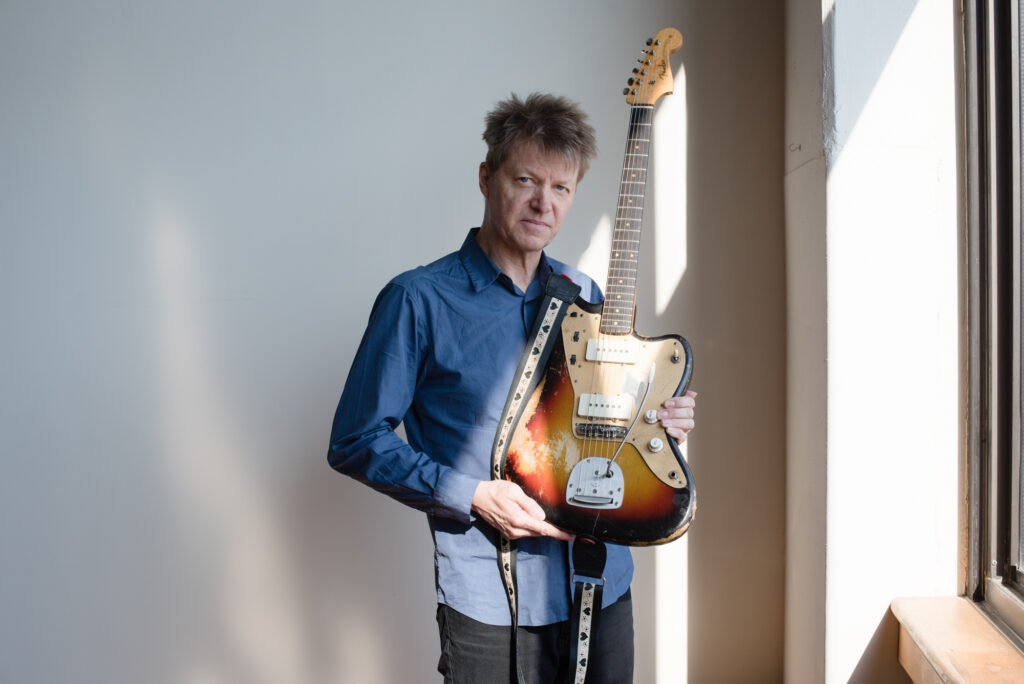
For 30 years, through different bands and sounds and a decade and counting with Wilco, Cline never gave up on his “mood music” concept album. “It was always going to be called Lovers,” he explains. “Periodically, some very sincere person wanted to sign me to jazz record labels, under the auspices of major labels,” he recounts. “And both times this happened, I was asked, ‘What, what if you could do any project?’” Lovers of course, was always the first answer (a duo album with turntablists was a second idea he’d float).
When Cline joined Wilco in 2004, his profile increased dramatically. He was working on some of the most accessible music in his career and he became a bit of a guitar/tone hero. His solo on the band’s “Impossible Germany” has been dissected, analyzed and attempted by thousands of young (and not so young) guitar students. His usage increased the value of the Klon Centaur—in a way, he’s always been the Johnny Appleseed of the boutique pedal movement. Beyond the rock shows, Cline continued to work on his own projects and collaborations, including his recent collaborations with Julian Lage, whom he met through Jim Hall.
“Then I met David Breskin,” he continues, bringing the conversation back to Lovers. “I was commissioned by him to do music for this book project that he did with Ed Ruscha’s artwork and poetry called Dirty Baby. David and I became friends and really enjoyed working together. He’s a super supportive guy and also part of a philanthropic organization called the Shifting Foundation. He asked me the question, ‘What would you want to do if you could do anything?’ He said, ‘List every project that you have, that you’ve ever thought of that that you want to do…’ At the top of the list, still, was Lovers.
“He loved this idea,” Cline says. “He was the one who kind of kept nudging me and prodding me and saying, ‘What’s going on with Lovers?’” Thanks to Breskin, Cline was bestowed production funds through the Shifting Foundation to start the project, which still had no record label. More time went on. “I was too scared to start arranging it, because I felt I was not really up to it,” he says. “Trying to get more traditional orchestrations and arrangements were not really my realm of expertise. Then I met Michael Leonhart.”
Cline and his wife, musician Yuka Honda, live next door to Leonhart, a trumpeter, arranger and producer who has performed with everyone from Yoko Ono to Q-Tip to Steely Dan. He even won a Grammy while in high school. “We were having dinner in his apartment with his wife and son and just sitting around eating pizza, playing records and talking,” Cline recalls. “And this then led to a whole talk about Quincy Jones and Johnny Mandel. And then I told him about the Lovers project. He just said, ‘Let me help you with this, please.’ That was how this finally happened.”
Cline refined his song list—a mix of original material and covers. Leonhart would coach him on the arranging, getting Cline’s input on solos and instrumentation. “I had told him I didn’t want really hardly any saxophone on the record; it was going to be mostly clarinets, flutes and brass, along with percussion, rhythm and additional strings,” Cline says. “And then he’d say, ‘Write a coda for this’ and then I’d write a coda. And then he would sit and play it on the piano. Then he would orchestrate it brilliantly. On my own songs, I didn’t have very many ideas as to how to arrange stuff. I just left it up to him.
“I just did lead sheets,” Cline adds. “And I wrote specific notes for specific harmonies. For example, on ‘Secret Love,’ I wanted to have this polyrhythm with this 5/8—it’s a cluster chord that represents a heartbeat. It’s kind of an homage to Jim Hall, this piece. I play it in A-flat, which is Jim’s key that he played it in on the Jim Hall Trio Live in Japan record, one of my favorite records. I even play a couple of almost exact licks from his live version of that song. I thought that would really delight him [to hear]. He died on the last day of tracking.It was pretty crushing.”
After writing out the arrangements, Cline and his ensemble went to a studio in New Jersey to record the album. Recorded in five days, it was a relatively quick affair, especially for a double album. (“We used every, every moment, but it wasn’t harried. It didn’t get, it didn’t get frantic. And then we did the strings and harp in one day,” Cline says). “Everybody who was on the record are either people that I have insane respect for and sort of know or they’re people that I’ve known for a long time and and love. It was a super lovely confluence of individuals coming together for this.”
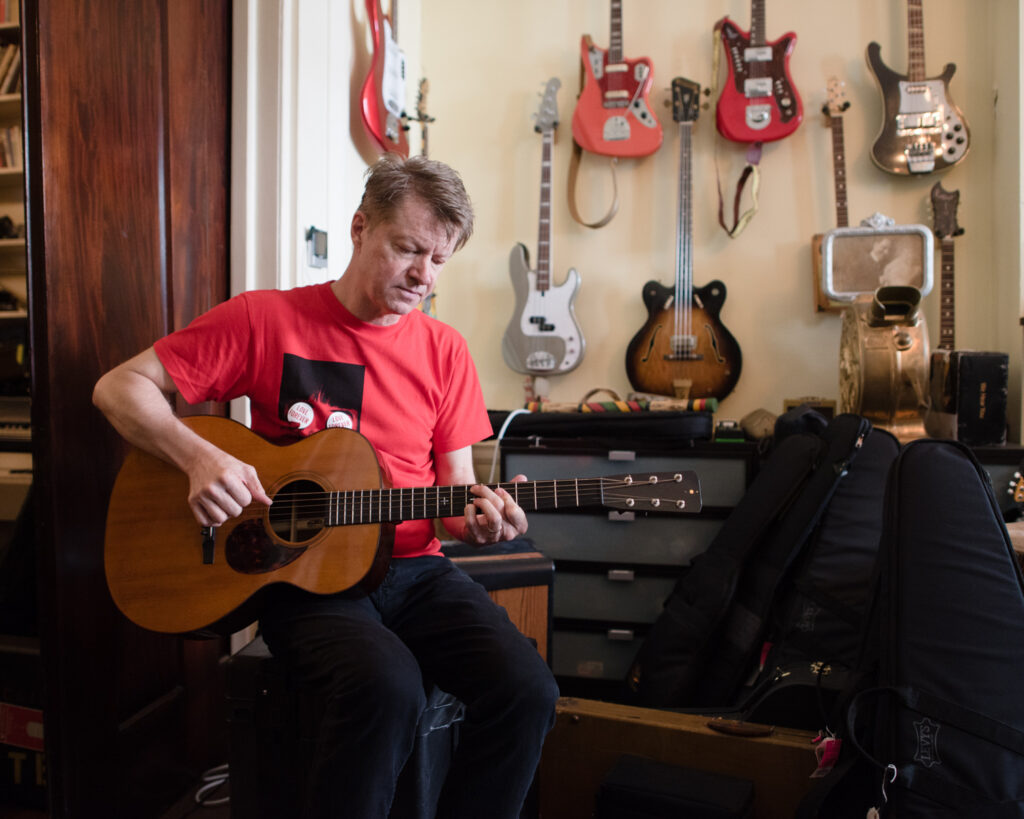
Cline obviously knows his fair share of guitarists (for a while, he and Bill Frisell used to share a small apartment in New York City—constantly touring, they’d rarely cross paths). But for the guitar parts on Lovers, it’s all either him or Lage. “He and I have this thing, this kind of chemistry,” Cline says. “I just knew that this was a great assignment and that for me, it would make my life beautiful, because I always play better with Julian than without him. Lage’s duties ranged from playing resonator guitar on “The Night Porter” to doing his best Freddie Green impersonation on “Why Was I Born.”
For his own guitar parts, Cline’s main instruments were his 1964 Gibson Barney Kessel and a Partsmaster (“a vintage Jazzmaster body and vintage tremolo with Seymour Duncan PAFs that look like Jazzmaster pickups,” he explains. “They’re fantastic for me, because sometimes I go into these sessions and nobody wants to hear a speck of 60 cycle hum”). He used a Jerry Jones Neptune on the intro to “Invitation,” a Fano 12-string, a BilT Volare and a 1962 Gibson J-200 that he played amplified on “So Hard It Hurts” and unamplified on “Touching” in the album’s Annette Peacock suite.
After all of this work and the recording sessions, Cline had a double-album that still didn’t have a record label. “I sent it to a label that had already been interested in it and was expecting it, and then never heard anything from them for like four months,” he says. “I sent them one little reminder, like, ‘Hey, you might want to listen to this,’ and then never heard anything.” He asked his manager for advice and eventually decided to form his own label. “We all put our heads together to figure out how to make this possible, how I would make X amount of money back, and then how we’re going have to pay all this licensing for all these cover songs and get permission because I wanted to put the lyrics in the package. I always wanted to have the lyrics [there] even though there’s no singing on the record, because generally the lyrics are as important to my selection of the song as the music.
“Literally in the 11th hour, when we had already designed the album cover, I found out that my manager, Ben Levin, sent a copy to Don Was at Blue Note,” Cline recalls. “He was interested in licensing it.” Lovers, 30-plus years in the making, was finally completed.
Is this the start of a long career where Nels Cline releases records on one of the world’s great jazz labels? Nels doesn’t think so. “What Don Was said to my manager was something like, ‘I’ve been following Nels for a while and I really like his work, but this is the only thing we could ever release by him,’” Cline says with a laugh.
See also:
Strings Attached — Nels Cline’s favorite ensemble jazz albums
